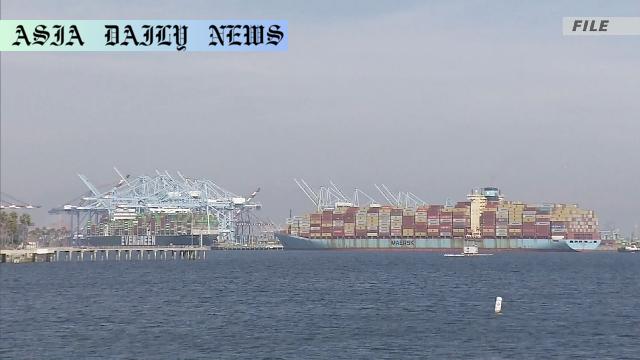US-China Trade Pressure – President Trump intensifies trade conflict with China’s shipping industry to boost American shipbuilding.
US introduces new port fees targeting Chinese-flagged ships.
Fees aim to counter China’s dominance and revive US shipbuilding.
China protests, citing disruption to global supply chains and shipping costs.
The fees are phased and based on net tonnage or container volume.

Introduction: The New Port Fee Policy
The Trump administration has launched a new initiative to strengthen its stance in the ongoing trade conflict with China. As part of this move, the United States is imposing new port fees on Chinese-flagged or Chinese-built ships entering US ports. According to the US Trade Representative (USTR), these efforts are designed to revive the American shipbuilding industry and reduce China’s dominance in the global shipping sector. The fees will come into effect within six months and will be implemented in phases, with the amounts varying based on the ships’ net tonnage or container capacity.
The Legal Basis: Section 301 of the Trade Act
This decision is grounded in Section 301 of the Trade Act, a regulation designed to counteract unfair trade practices by foreign partners. US Trade Representative Jamieson Greer stated that this move will not only curb China’s influence but also address vulnerabilities within the US supply chain. He further emphasized that the policy is structured to stimulate demand for US-built ships, a sector that has been long overshadowed by China’s dominance.
China’s Response to the Fee Implementation
The announcement has been met with strong opposition from Beijing. Lin Jian, spokesperson for China’s Foreign Ministry, expressed concerns over the detrimental consequences of the new policy. He stated that it would disrupt global supply chains, increase maritime shipping costs, and ultimately harm both US and global interests. Furthermore, Lin urged Washington to abide by multilateral trade rules and cautioned that China would take all necessary measures to protect its interests.
Impact on the US and Global Economy
The implications of this new measure extend beyond the two nations involved. By increasing operational costs for Chinese-owned vessels, the US hopes to protect its domestic industries and level the economic playing field. However, this step may inadvertently escalate tensions, leading to retaliation from China and disruptions in international trade. Additionally, global consumers could bear the brunt of increased shipping fees, with prices possibly rising across various sectors reliant on maritime imports.
Industry Experts Weigh In
Many analysts have voiced opinions on the broader implications of this policy. Some applaud the move, emphasizing its potential to revive the ailing US shipbuilding industry and create jobs. Others, however, express skepticism, citing potential backlash from allies affected by supply chain disruptions and the financial uncertainties tied to escalating tariffs and penalties. The long-term success of this strategy hinges on how effectively the US can mitigate these challenges while doubling down on domestic industry support.
Conclusion: A Bold Yet Risky Strategy
The Trump administration’s decision to impose port fees on Chinese vessels marks a significant step in the broader trade dispute. While it highlights America’s resolve to counter China’s growing economic influence, it also introduces a set of challenges that could affect not only the two nations but also the global trade landscape. Whether these measures will achieve their goals of rejuvenating US shipbuilding and safeguarding vital supply chains remains uncertain, but their impact will undoubtedly be felt worldwide in the coming months.



Commentary
Introduction: A Complex Trade Landscape
The recent announcement by the US administration to impose new port fees on Chinese-flagged ships is both a bold economic measure and a high-stakes gamble. This policy comes on the heels of prolonged trade tensions between the two global powers, underscoring the increasing complexity of their trade relationship. While President Trump’s administration aims to curb China’s dominance and revitalize domestic industries, the implications of such a move demand deeper analysis.
Addressing US Shipbuilding Decline
The decline of the American shipbuilding industry has long been a sore point for policymakers. This new policy could encourage investment in domestic shipyards and create jobs, fulfilling a critical need for economic diversification. However, the feasibility of this goal depends on several variables, including how US stakeholders manage to address the skills gap and compete with China on cost efficiency. Without comprehensive reforms, this initiative risks becoming a costly and ineffective endeavor.
Global Fallout: Disrupting Supply Chains
The global supply chain repercussions of the new fee policy cannot be understated. As shipping costs rise, businesses dependent on affordable import-export operations may find themselves squeezed, and these expenses may trickle down to consumers. At a time when economic recovery is still tenuous worldwide, such disruptions could spark criticism from US allies and international trading partners.
Conclusion: Striking a Balance
While the intent behind the US administration’s move to impose new port fees may appear logical, its outcomes remain uncertain. If mishandled, it could further entrench economic rivalries and create new challenges for global trade networks. Moving forward, policymakers must strive to strike a balance between supporting domestic industries and maintaining harmonious international trade relations.